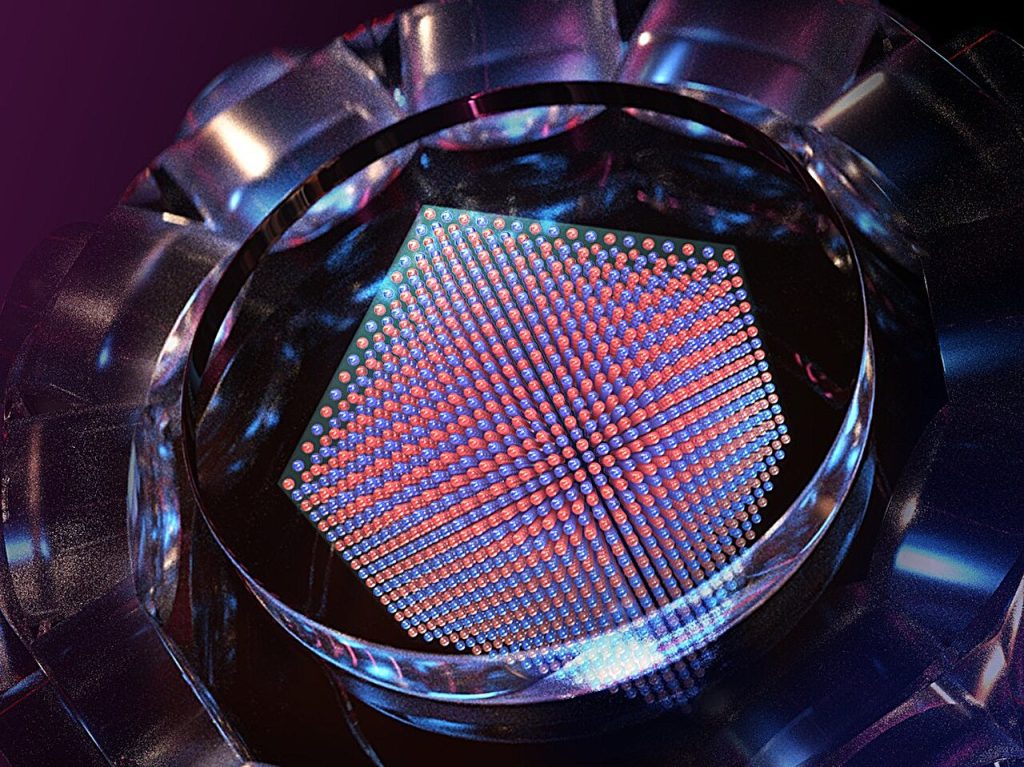This image depicts an ultracold atom quantum simulator. The red and blue balls represent fermionic atoms with spin up and spin down, respectively, arranged alternately in 3D space to form an antiferromagnetic crystal. The glass cell provides an ultrahigh vacuum environment for the ultracold atoms. Credit: Chen Lei
In one study Published in NatureThe research team observed an antiferromagnetic phase transition for the first time in a large-scale quantum simulator of the Fermionic Hubbard model (FHM).
This work highlights the benefits of quantum simulation, which represents an important first step towards realizing it at low temperatures. step The research team, led by Professors Pan Jianwei, Chen You and Yao Xingcan from the University of Science and Technology of China (USTC), Chinese Academy of Sciences, aims to map out the FHM and understand the role of quantum magnetism in the mechanism of high-temperature superconductivity.
Strongly correlated quantum materials, e.g. High-Temperature Superconductors are of scientific importance and have the potential to provide economic benefits, but the physical mechanisms underlying these materials remain unclear, and large-scale fabrication and application pose challenges.
The FHM is a simplified representation of the behavior of electrons in a lattice, capturing a wide range of physical phenomena related to strong correlations. Quantum MaterialsTherefore, it is believed that this could provide a solution to understanding the mechanism of high-temperature superconductivity.
Research into FHM faces challenges: the model in two and three dimensions lacks exact analytical solutions, and its high computational complexity means that even state-of-the-art numerical methods can only explore a limited parameter space. Moreover, theoretical studies suggest that even general-purpose digital quantum computers will have difficulty solving the model exactly.
Quantum simulations using ultracold fermionic atoms Optical latticemay be the key to plotting the low-temperature phase diagram of FHM, for which the most crucial step is to realize the antiferromagnetic phase transition and reach the FHM ground state at half-filling.
Such an achievement validates two key features of the quantum simulator: the establishment of a large-scale, spatially uniform optical lattice for uniform Hubbard parameters and maintaining the system temperature significantly below the antiferromagnetic phase transition temperature, the Néel temperature, both of which are essential for investigating the role of quantum magnetic fluctuations in the mechanism of high-temperature superconductivity.
However, the difficulty of cooling fermionic atoms and the inhomogeneity introduced by standard Gaussian-distribution lattice lasers have prevented the realization of the antiferromagnetic phase transition in previous quantum simulation experiments. Previous Achievements In the field of creating and investigating strongly interacting homogeneous Fermi gases in a box potential, we have developed an advanced quantum simulator by combining the generation of a low-temperature homogeneous Fermi gas in a box trap and the demonstration of a flat-top optical lattice with a uniform site potential.
This quantum simulator contains about 800,000 lattice sites, roughly four orders of magnitude larger than current experiments with a few dozen sites, and has uniform Hamiltonian parameters at temperatures significantly below the Néel temperature.
Leveraging this setup, the team precisely tuned the interaction strength, temperature and doping concentration to approach their respective critical values and directly observed conclusive evidence of an antiferromagnetic phase transition: a power law divergence in the spin structure factor, with a critical exponent of 1.396 from Heisenberg universality.
This work deepens our understanding of quantum magnetism and lays the foundation for further elucidating the FHM and obtaining its low-temperature phase diagram. It is noteworthy that experimental results deviating from half-filled conditions already exceed the capabilities of current classical computing, demonstrating the advantages of quantum simulations in addressing important scientific problems.
For more information:
Jiang-Wei Pan, Antiferromagnetic phase transition in the three-dimensional fermionic Hubbard model, Nature (2024). Publication date: 10.1038/s41586-024-07689-2. www.nature.com/articles/s41586-024-07689-2
Provided by
Chinese Academy of Sciences
Quote: Fermionic Hubbard quantum simulator observes antiferromagnetic phase transition (July 10, 2024) Retrieved July 11, 2024 from https://phys.org/news/2024-07-fermionic-hubbard-quantum-simulator-antiferromagnetic.html
This document is subject to copyright. It may not be reproduced without written permission, except for fair dealing for the purposes of personal study or research. The content is provided for informational purposes only.


